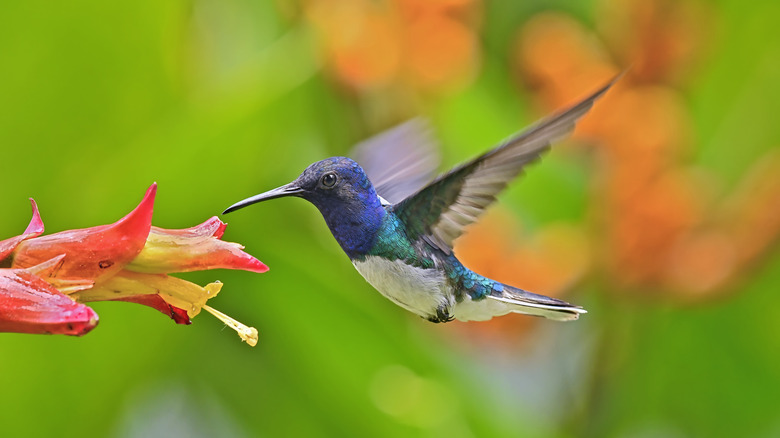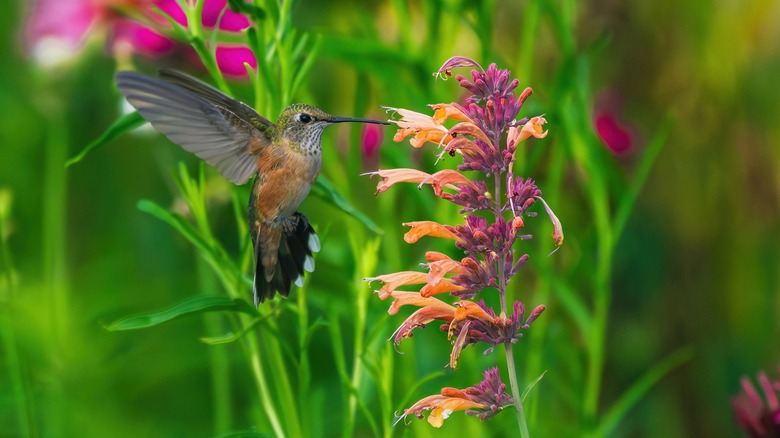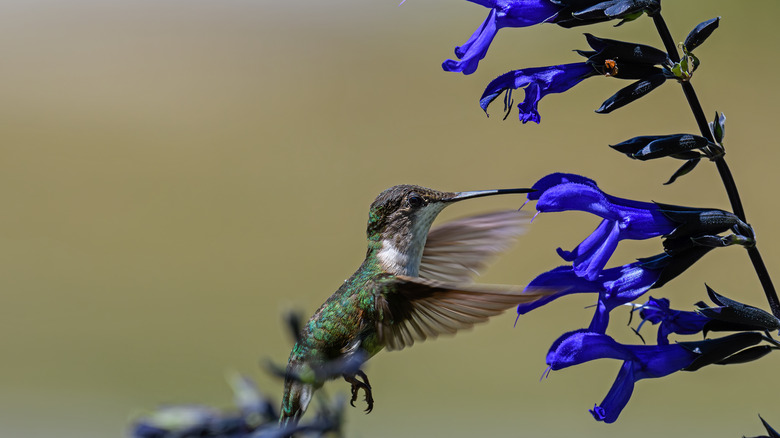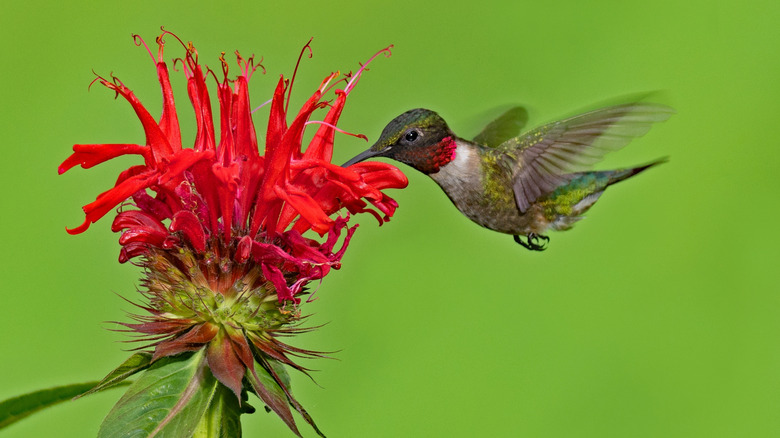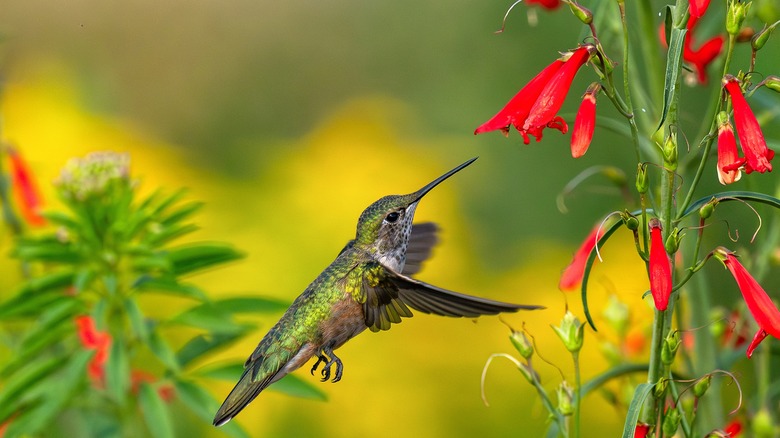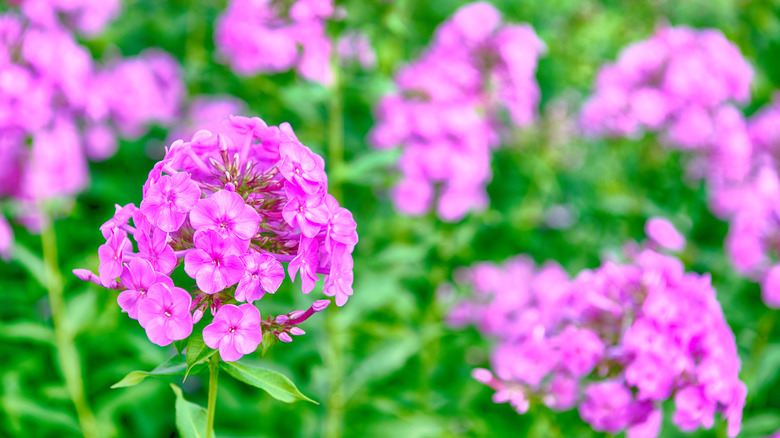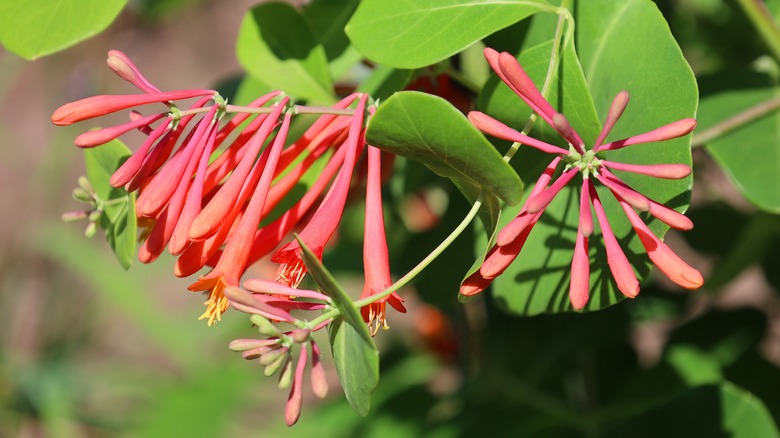7 Perennials You Shouldn't Deadhead If You Want Hummingbirds In Your Yard
Your garden is your pride and joy, so you probably want it to look neat and tidy all year round. But there are certain perennial plants you should hold off deadheading if you want hummingbirds in your yard, such as hummingbird mint and salvia. In the late summer months, a lot of hummingbirds begin their migration south. Some begin flying down as soon as July, with most hummingbirds leaving for warmer climates by October.
On their journey, they will stop in gardens to feast on plants and get the energy they need to continue. They can stop at a garden for up to a week, depending on how much fat they have stored. To help them migrate for winter, you can hang up a hummingbird feeder at the right height and ensure that the flowers in your garden are at their best for these nectar lovers. Certain perennials do need deadheading to promote more blooms for hummingbirds to enjoy. But others, particularly those that bloom later in the summer, should be left alone. Let's take a look at them so you can make your yard a hummingbird haven and support these wonderful creatures.
Hummingbird mint
Hummingbird mint (Agastache) is a gorgeous perennial that produces long spikes of purple blooms and is cold-hardy in USDA Hardiness Zones 5 to 9. As its name suggests, hummingbirds love this flower and will constantly visit it for nectar. Some gardeners do deadhead hummingbird mint to stimulate new flower growth, but as this perennial is not that speedy at producing new blooms, you may wish to forego this in order to keep the hummingbirds happy. However, if you don't want more of this perennial in your garden, be aware that hummingbird mint self-sows and will spread from old flower heads.
Salvia
Salvias come in a range of colors and are pretty low-maintenance, which makes them a favorite for beginner and expert gardeners alike. They are also a favorite for hummingbirds, who love colorful, tubular blooms. Although it depends on the variety of salvia, many bloom in spring and early summer. They can be deadheaded after their first flowering in May and will rebloom, sometimes even into fall, but they may not produce any more flowers if you deadhead them later on in the season. The same flowers will keep replenishing their nectar, allowing the hummingbirds in your garden to drink from them again and again.
Cardinal flower
With their showstopping red blooms, cardinal flowers (Lobelia cardinalis) bring color and fun into your yard, as well as the hummingbirds that they attract. These flowers generally don't need deadheading, so leave them on as they bloom through summer and into fall. As these are short-lived perennials, it is also helpful to let the blooms turn and spread their seeds. This will bring new seedlings into your garden, providing hummingbirds with food year after year. As cardinal flowers bloom until mid-autumn, they are a great perennial to support the hummingbirds who migrate later. They are hardy in zones 3 to 9.
Beebalm
Beebalm (Monarda didyma) is a wonderful native perennial that blooms from July until September and is hardy in zones 4 to 9. It is okay to deadhead them earlier on in the season to promote new blooms, but this is not necessary towards the end of summer, as they may not grow any more flowers. Furthermore, native bees nest in the hollow stems of dead plants, so it is helpful to leave beebalms intact to bring biodiversity into your garden. This creates a haven for all sorts of pollinators, not just our beloved hummingbirds.
Penstemon
With their dramatic blooms in bright, vivid colors, penstemon is a wonderful addition to any yard and is a favorite for many migrating hummingbirds. Penstemons are pretty low-maintenance, and deadheading is only really necessary if you want a tidier look. These flowers are quick at replenishing their nectar, too, so leaving the flowers on the stem will provide hummingbirds with more food. Furthermore, songbirds eat their seeds, so allowing the flowers to turn to seed will help feed more wildlife in your area. They are hardy in zones 5 to 8.
Garden phlox
Garden phlox (Phlox paniculata) is a great late bloomer that flowers from June to September and is hardy in zones 4 to 8. While other flowering perennials may be long gone by early fall, garden phlox still thrives, providing nectar for hummingbirds and other pollinators. If you tend to get hummingbirds in your yard late in the season, definitely consider planting garden phlox if you don't have any! When it comes to deadheading these, it's best to skip it and let them be. However, garden phlox does self-seed, so keep an eye out if you don't want more in your garden.
Native honeysuckle
With its intriguing, trumpet-shaped blooms that come in hues of red, orange, and yellow, native honeysuckle (Lonicera periclymenum) is a cheerful plant that is great for wildlife and pollinators. It is hardy in zones 4 to 9 and blooms in spring and summer, but can have a second flowering later on in the season. Leaving native honeysuckle to do its own thing will allow it to (hopefully) bloom again and provide more feed for the hummingbirds. Plus, the flowers on native honeysuckle turn to berries that other birds enjoy munching on.
